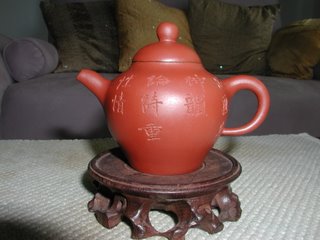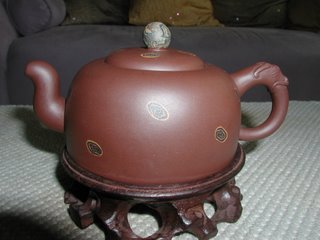The word tips is commonly used as gratuity today, many of us may not know where it came from. Have you ever wondered how many words or phrases are tea related?!
Tipping as a response to proper service developed in the Tea Gardens of England. Small, locked wooden boxes were placed on the tables throughout the Garden. Inscribed on each were the letters "T.I.P.S." which stood for the sentence "To Insure Prompt Service". If a guest wished the waiter to hurry (and so insure the tea arrived hot from the often distant kitchen) he dropped a coin into the box on being seated "to insure prompt service". Hence, the custom of tipping servers was created.
It's bribery when a patron had to tip in advance to insure prompt service, where it's gratuity, showing appreciation after prompt service is received. Good service should be mandatory in any service business within reason, so we expect it to be in today's society.
Merriam Webster: Tip - a gift or a sum of money tendered for a service performed or anticipated.
Sunday, October 29, 2006
Ji Xiang Yu Yi Xishi hu
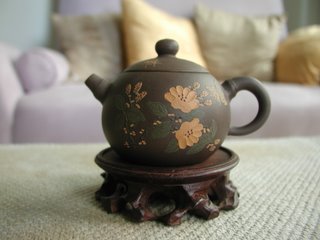
130ml... I am using it as Cha Hai. Instead of using the same Cha Hai for every tea, I am pairing up tea pots for a specific tea. One pot for brewing and the other for cha hai, it's a fast way to raise pots by raising 2 at the same time instead of just one. I prefer honey comb filter pots for brewing, flat filter pots are then used as cha hai-s.
Sunday, October 22, 2006
Yixing yellow clay pot
Saturday, October 21, 2006
Sunday, October 15, 2006
Carved bronze teapot
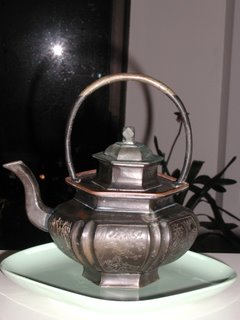
Bronze teapot in the shape of a flower basket or Chinese lantern. Six sides all hand carved with a man or woman in landscaping: a man laid under bamboo trees, a man smoking pipe under a pine tree, a man holding peaches under banana trees, a man crossing a bridge with a fish and fishing rod, a woman playing a flute under a willow tree, a man drinking tea under a prune tree. Amazingly, the spout does not back pour, no dripping!
I need to clean the green bronze rust before I can figure out whether it's useful or not. At current condition, it's not suitable for making tea. Any one know how to clean this thing up?
Hand painted (?) prune flower cups
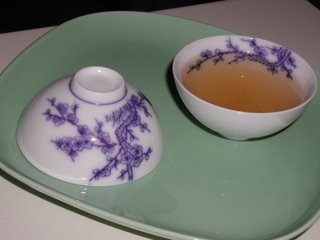
Lovely porcelain cups, classic blue and white. Very thin wall. Cups very snuggly in hand.
Since the Ming Dynasty, white porcelain tea wares became popular due to the change of tea drinking preference. Loose leaves became popular, mostly contributed by the first emperor of Ming. He ordered contribution tea in loose leave form instead of the cake form in previous dynasties. Ming was also the period when tea was steeped instead of cooked in Tang period and powdered (Dian Cha - similar to Matcha) in Song. White porcelain can reflect the true color of tea soup.
It's interesting how everyday life was and still is influenced by government in every corner of the earth, ie Boston tea party?!
Prune flower gaiwan

A new style of gaiwan, a bowl without the holder. Hand painted prune branches and blossom, base color is light greenish blue. The bottom rim is thicker and higher than normal rice bowl. I am not sure what is the function of this variation. Perhaps hot tea is hotter than rice, so more insulation for your fingers?
Saturday, October 14, 2006
Song style gaiwan tea set
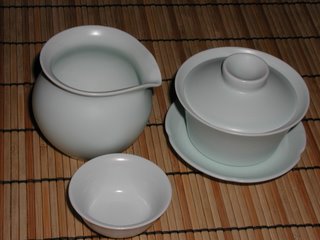
Modern production of Song Dynasty style ceramic ware made famous by a kiln named Ru Yao 汝 窯 which specialized in light green/blue porcelain.
This set comes with 8 cups, a gaiwan and a cha hai for $16. This is what I call a deal. Wall of the gaiwan is thick, the cup size also shows it's suitable for pu-erh. Love the flower shape of the gaiwan holder. Well, flaws are expected for something this price. I found a few grains of black sands here and there, also popped air bubbles on the glaze during firing. One of the cup's inside was not glazed evenly. Over all it's nicely designed with beautiful color, good smooth substantial weight hand feel. Gaiwan is particularly lovely!
Friday, October 13, 2006
How and when to put green tea leaves in hot water
How and when to put green tea leaves in hot water... It's more complicated than one can imagine.
First of all, there are 3 basic ways to add tea leaves in hot water in the case of green tea:
1, top throw (Shang Tou), add leaves after cup is filled up with hot water to top
2, middle throw (Zhong Tou), fill cup 1/5, then add leaves, let it soak for 20-30 seconds, then fill hot water all the way to top
3, bottom throw (Xia Tou), add leaves to empty cup, then fill with hot water to top
Which "throw" to use can be seasonal, summer and fall can use top throw, spring and winter can use bottom throw. Delicate leaves such as top grade spring Lung Jing or Bi Luo Chun can use top throw, medium size or hairy tips such as Mao Jian can be middle throw, Jasmine pearls should use bottom throw. The logic behind it is, the smaller and more delicate leave which can't take high heat should use top throw; while something needs more time to open up but can't be "cooked" with hot temperature use middle throw; something can with-stand or require higher temperature use bottom throw.
First of all, there are 3 basic ways to add tea leaves in hot water in the case of green tea:
1, top throw (Shang Tou), add leaves after cup is filled up with hot water to top
2, middle throw (Zhong Tou), fill cup 1/5, then add leaves, let it soak for 20-30 seconds, then fill hot water all the way to top
3, bottom throw (Xia Tou), add leaves to empty cup, then fill with hot water to top
Which "throw" to use can be seasonal, summer and fall can use top throw, spring and winter can use bottom throw. Delicate leaves such as top grade spring Lung Jing or Bi Luo Chun can use top throw, medium size or hairy tips such as Mao Jian can be middle throw, Jasmine pearls should use bottom throw. The logic behind it is, the smaller and more delicate leave which can't take high heat should use top throw; while something needs more time to open up but can't be "cooked" with hot temperature use middle throw; something can with-stand or require higher temperature use bottom throw.
Tuesday, October 10, 2006
In the mood for some Worm Tea?
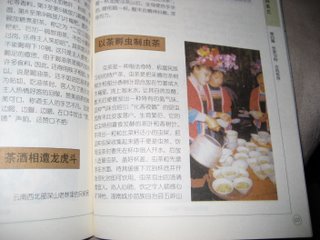
In the province of Hu Nan, ranges of Wu Ling mountain resides a minority group Miao zu. They have a custom of drinking Worm Tea that many have unheard of. The process of such tea is more than one can stomach.
Fresh tea leaves along with local fresh spice leaves are soaked in rice rinsing water, then proceed to fermenting for a few days, the ammonia from fermentation attracts worms of moths, these worms feed on the leaves and tea-rice mixture, then shit out little poppy seed size stools in the tea mixture. The collection of these worm stool is then rinsed and dried in the sun. When making worm tea, add hot water to cup, then the stools, cover for 5 minutes. Stools were floating at first, then slowly sink to the bottom, when dissipated, it's ready to drink. Yummy, so they say....
The name Worm Tea is absolutely deceiving!
After giving it some thought, I can only explain in this "logical" way. The fermentation is similar to the normal fermentation only liquid is added to speed the process. The digestion of these tea through worms is similar to the rolling and mixing of flavors (spice and rice), instead of by human hand, the worm digestive system did the work. When the final product is done "fermenting", "rolling" and "Roasting", dry naturally as usual - in sun light. Truly ORGANIC and NATURALE?!
Monday, October 09, 2006
Taiwan Lung Jing


It's been a while since I got this Taiwan Lung Jing sample from "Old Brand". I finally have the time to sit down and try this tea.
Taiwan Lung Jing is different from the Zhe Jiang Lung Jing from Mainland in many ways. 1st is the tree varietal, 2nd is the size and shape of leaves, 3rd is the taste of course. Taiwan Lung Jing was an imitation of the Mainland LJ, when the army of early ROC moved onto the island, nostalgia was spread among soldiers after the migration, one of the most memorable item was LJ. Taiwan LJ was evolved from a local green varietal to meet the demand of immigrants.
2g, crab eye water, gaiwan
Dry leaves: Long, thin, green to dark green, some white hair covered leaves, various length, sign of broken leaves, ripen fruity aroma, hint of smoky
1st brew: after preheating gaiwan, filled up 1/5 of gaiwan, then added in tea leaves, let soak for 20s, then filled up to top with raising the water kettle in order to cool off the water a bid, 45s. Sweet taste like dried Guei Yuen (a dried fruit similar to LiChi), smooth and clear, light amber yellow color
2nd brew: filled crab eye from side of gaiwan, steeped for 1 min, more yellow, hint of astringency, less sweet, not much aroma, getting weak
3rd brew: 2 min, yellow, astringent, over cooked tea taste, flat
Over all, a very light tea, good for a single brew, not bad but nothing impressive either.
Subscribe to:
Comments (Atom)

